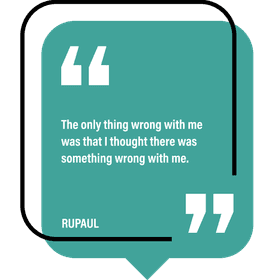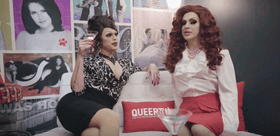Working with talent can often be one of the most exciting parts of working in media and advertising, and it can also be one of the things that’s hardest to get right. In true drag fashion, everything is accentuated, and working with drag queens is no exception.
As drag queens enter the mainstream, more brands are beginning to collaborate with them, more blockbuster productions are beginning to cast them, and more marketers are beginning to manage them.
Though a staple of the LGBTQ community, drag is adored by straight, gay, trans and cis fans alike, making drag queens prime collaborators across almost every industry. That said, working with drag queens isn’t really something you learn about in your marketing or business classes.
However, having worked with dozens of queens over the last 10 years, we’re here to help make your partnership a success.
1. Why Drag Has Become Mainstream, and Why It Matters for Marketers
As a result of the success of RuPaul’s Drag Race and society’s greater acceptance of the LGBTQ community, drag queens, once confined to local gay bars, have seen new opportunities that have never before been possible.
Take Shangela, a fan favorite on multiple seasons of RuPaul’s Drag Race. She frequently performs at LGBTQ-oriented events (like her iconic Beyoncé performance at the GLAAD media awards, in front of Beyoncé herself), and is now a household name. Having already earned a spot in A Star Is Born and a McDonald’s commercial, she recently announced a role on the CW’s Riverdale.

However, having a drag show on TV doesn’t fully explain why drag has gone mainstream. There are many factors that explain the rise, but here are a few key themes to note.
A. For the LGBTQ community, watching drag race is like a sport. You cheer on the queens like you would a team, and for many, this has provided a sense of community and comradery that they have missed out on. This connotation is vital to understand drag’s cultural prominence in the LGBTQ community. B. In a time when over 50% of Millennials think that the media hinders body positivity, drag is a breath of fresh air. Drag queens are accepted and loved in all sizes, and in drag, there’s a greater amount of body representation than in many other forms of entertainment, generally speaking. Drag shows us all that we should love ourselves, always, and that we’re fabulous, always. This is a message that has clearly resonated as much outside of the LGBTQ community as it has within, and is useful for marketers to keep in mind.
C. More broadly speaking, drag is digital and young. Memes and GIFs are some of the most popular form of shared content, and the over-exaggeration of drag culture lends itself beautifully to both mediums. Drag content spans every corner of the internet, with younger users leading the charge. That’s one reason that the FDA worked with us in trying to curb tobacco usage among younger adults. For the campaign, we hired some of our favorite queens (pictured below).

So, now you understand a bit more about drag and why its risen in prominence in the mainstream, and you’re thinking about working with a drag queen in an upcoming campaign. Here are some practical tips to making sure your partnership is an enormous success.
2. See a drag show if you haven’t before
If you’re looking to better understand the world of drag, we highly recommend you go see a drag show if you haven’t before. Go with friends, gay or straight, it doesn’t matter. Almost 60% of our readers say they’ve gone to a drag show with a straight friend, so if you don’t identify as LGBTQ, don’t sweat it. Just be open-minded, and always remember to tip! GayCities is a great resource to find local gay bars, so check it out!

Our team absolutely loves drag, and if you’re in the LA area and have never been to a drag show, here’s my proposition; let’s go together! Seriously, I’d be happy to show you the ropes.
Before you see a show, we’d recommend you take a look at this list of basic drag terminology so you get the most out of it!
3. Work with the spirit of drag, not against it.

Part of the business appeal of working with drag queens is their authenticity, sharp humor, and ability to make fun of everyone and everything, equally. In today’s climate where consumers highly prioritize authenticity in advertising, and where Gen Z (a generation which identifies as LGBTQ higher than any other) can see through inauthenticity from a mile away, success lies in working with this spirit of Drag.
When we start a campaign, we think a lot about which queen is the right fit, considering factors such as aesthetic, tone of voice, location, etc… Drag is all about self-expression, so we try to work with the talent’s personality and strengths. This isn’t to say that there aren’t brand guidelines or scripts, but when you start off with an intentional match between queen and brand, it’s much easier to create a winning campaign.
A great example of this (if we do say so, ourselves) is Queerty’s recent video series, That’s Our Sally, in partnership with Gilead. https://youtu.be/xNtMk_33F94
For the three-part series, we knew that Drag Legend Trixie Mattel would be a great fit. In the series, Trixie maintains her signature look and her naïve-yet-steamy persona, in order to work with the content, not against it. She comes across authentically, which encouraged organic viewership and shares among Trixie’s fans and Queerty’s.
Proof? In just the first week alone, the first video garnered over 60K views.
Moral of the story: where authenticity goes, engagement follows.
4. Terminology: how do you address a drag queen in a professional setting?
So, you’re about to send that initial outreach email to see if one of your favorite queens is interested and available for a new partnership, but wait…what do you call them?
This was a question I had when I first started working at Q.Digital. One of my first and most exciting projects was creating the Queerty social lounge on the set of Will & Grace. For the lounge, we brought in two queens from previous seasons of RuPaul’s Drag Race, Pandora Boxx and Morgan McMichaels.
In my initial email to them, I realized that I had never addressed a drag queen in a professional email. What do I say? Ms. Boxx? Mrs. McMichaels? What pronouns do they prefer? I was not prepared for this. Good thing I work on a team that has a lot of experience in this arena.
Their answer?
There’s no right or wrong way to address a drag queen. When they’re in drag, the most common way to address a queen is to use their drag name and pronouns of that persona (i.e. I would refer to Pandora Boxx as a “she” when she’s in drag). Out of drag, many people still refer to queens as their drag names, especially if they’re generally working with them in drag.
However, that’s not always the case. If you’re close with someone that you know in and out of drag, some people prefer to go by their “real” names. Some don’t.
The simplest way to find out is just to ask.
5. Day-of tip: Drag takes a lot of time
While hair and makeup for talent might generally take an hour or two, makeup for queens can take four or five, and pro tip, they do not like to be rushed! If you have a shoot coming up, be sure to ask your queen how much time they’ll need for hair and makeup, and if you expect them to come in full-face (meaning, showing up with their hair and makeup already done), be sure to communicate that ahead-of-time. Otherwise, you might accidentally add hours of time to your shoot day waiting for them to get into drag.
Over-communication is key, honey!
And there you have it…a quick guide to working with drag queens. We hope you found this information useful, and even more so, we hope you fall in love with drag as much as we have (if you haven’t already).
Lastly, if you’re interested in working with a drag queen as an influencer or partner, and want some expert help to make it happen, let’s chat! It’s kind of our thing 🙂
Links to the projects mentioned in this post:
Lessons in Flawless for This Free Life



